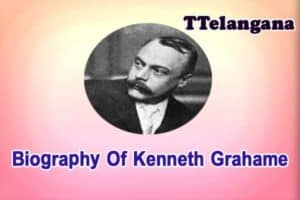Biography Of Kenneth Grahame
Kenneth Grahame was a British author best known for his timeless classic “The Wind in the Willows.” Born on March 8, 1859, in Edinburgh, Scotland, Grahame’s literary legacy endures to this day, enchanting readers of all ages with his captivating tales of animal characters and their adventures. His literary contributions have had a profound impact on the world of children’s literature, and his works remain popular and beloved across generations.
Early Life:
Kenneth Grahame was born to James Cunningham Grahame and Bessie Ingles on Castle Street in Edinburgh. He was the third of four children, with two older siblings, Helen and Roland, and a younger brother, Alastair. Tragedy struck the family early on when Kenneth’s mother died of scarlet fever when he was just five years old. Following this devastating loss, the family moved to Cookham Dene in Berkshire, England, to live with their grandmother. This change in surroundings would later inspire the idyllic riverside setting depicted in “The Wind in the Willows.”
Grahame’s childhood was marred by sorrow, and he sought refuge in literature and nature. He attended St. Edward’s School in Oxford, where he showed a talent for writing and storytelling from a young age. Despite his potential, financial constraints limited his educational opportunities, and he was unable to attend university. However, he was determined to carve a path in the world of literature.
Early Career:
At the age of 20, Grahame secured a position as a clerk at the Bank of England. The job provided financial stability, but he found it mundane and unfulfilling. To escape the tedium, Grahame turned to writing as an outlet for his creativity. He contributed stories, essays, and poems to various publications, slowly gaining recognition for his literary talent.
In 1893, Grahame published his first book, “Pagan Papers,” a collection of essays and stories. While it received modest attention, it did little to establish his reputation as a prominent author. Nevertheless, he continued to write, and in 1895, he published “The Golden Age,” a collection of children’s stories inspired by his own childhood experiences. The book received positive reviews, and critics praised his ability to capture the essence of childhood wonder and imagination.
“The Wind in the Willows”:
Grahame’s breakthrough came with the publication of “The Wind in the Willows” in 1908. The novel followed the adventures of anthropomorphic animals, including Mole, Ratty, Toad, and Badger, as they navigated the English countryside and the River Thames. Initially, Grahame wrote the story as a series of letters to his young son, Alastair, who was nicknamed “Mouse.” These letters formed the basis of the beloved book, which has since become one of the most cherished works in children’s literature.
“The Wind in the Willows” has been celebrated for its lyrical prose, vivid characterizations, and enchanting portrayal of the English countryside. The charming narrative explores themes of friendship, loyalty, and the desire for adventure while offering a nostalgic glimpse into a bygone era.
Biography Of Kenneth Grahame
Personal Struggles:
Despite his literary success, Grahame faced personal challenges throughout his life. His son, Alastair, whom he affectionately called “Mouse,” suffered from health issues and emotional difficulties. Grahame’s paternal instincts were strong, and he poured his heart into caring for his son. Tragically, Alastair’s emotional struggles continued into adulthood, and he took his own life at the age of 20 in 1920. This devastating loss haunted Grahame for the rest of his life.
Later Works and Legacy:
Following the immense success of “The Wind in the Willows,” Grahame wrote other works, including “The Reluctant Dragon” (1898), which remains popular among readers and has been adapted into various stage and film productions. However, he never reached the same level of success with subsequent works.
Kenneth Grahame retired from the Bank of England in 1908, the same year “The Wind in the Willows” was published. He spent the later years of his life in retirement, often in the countryside, seeking solace in nature. Despite his longing for a peaceful life, Grahame continued to face personal struggles, compounded by the loss of his son and his wife, Elspeth Thomson, in 1910.
Kenneth Grahame passed away on July 6, 1932, at the age of 73. He left behind a literary legacy that has continued to captivate readers for over a century. “The Wind in the Willows” has been adapted into numerous stage plays, films, and television series, solidifying its place in the canon of classic children’s literature. Grahame’s ability to infuse the natural world with anthropomorphic charm has inspired generations of authors and artists.
Tags: facts about Kenneth Grahame, biography of famous economists, author kenneth grahame, Kenneth graham, a biography written from one’s knowledge, kenneth grahame biography, kenneth r. Graham, the biography of kenneth hagin, biography of Kenneth hagin, first baptist church of ken-gar, kenneth grahame, grahame kenneth, biography of kenneth branagh, kenneth graham university of kentucky, kenneth graham kentucky, biography kenneth branagh, biography ken burns, about kenneth grahame, kenneth grahame author biography, wiki kenneth grahame, ken graham pastor, kenneth grahame books
